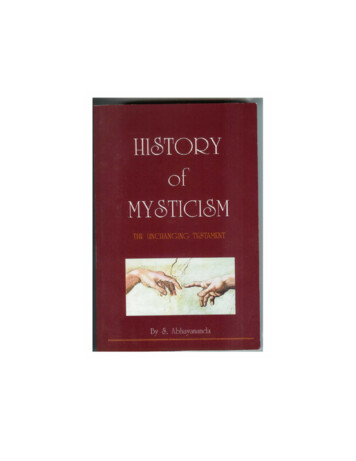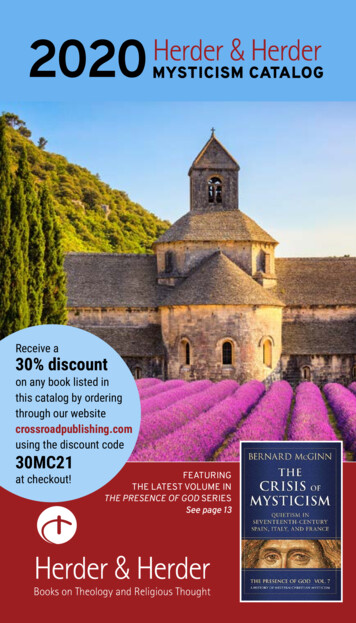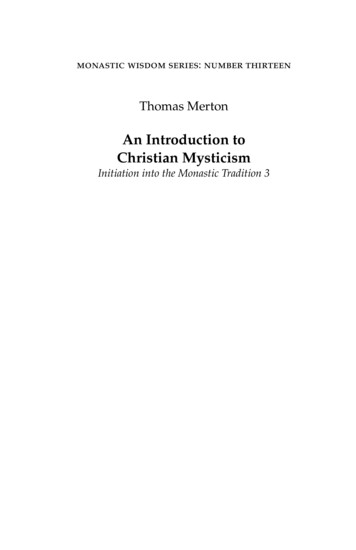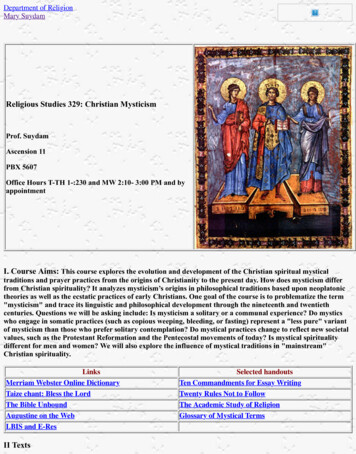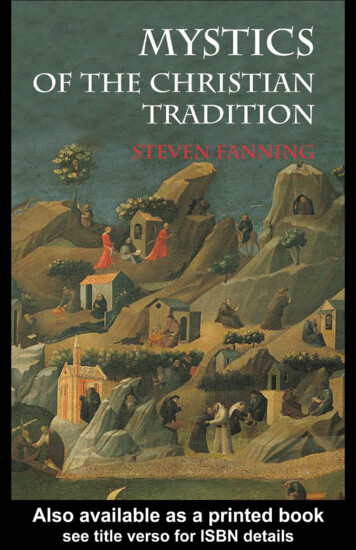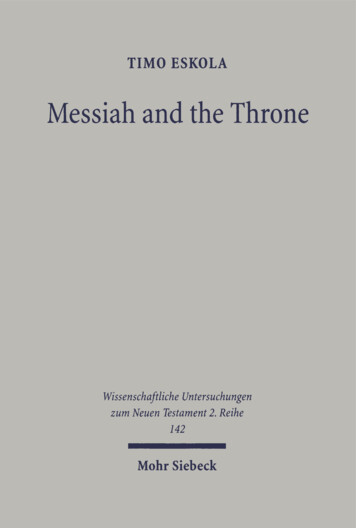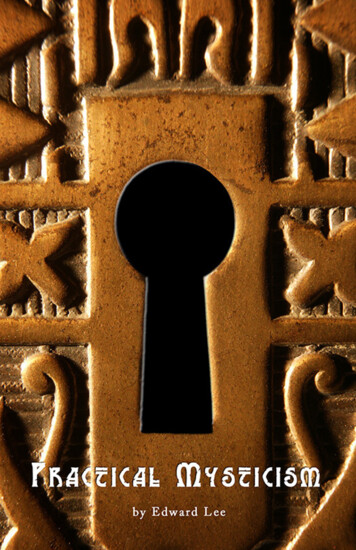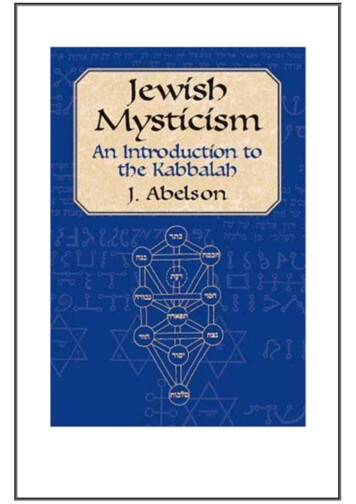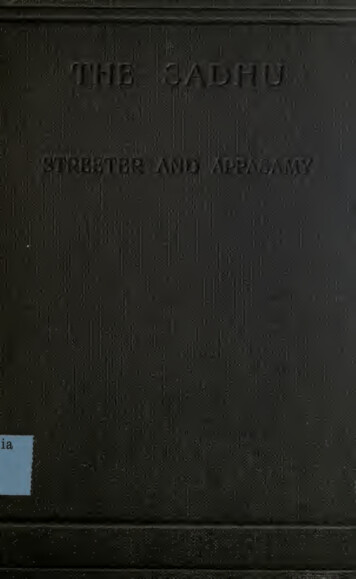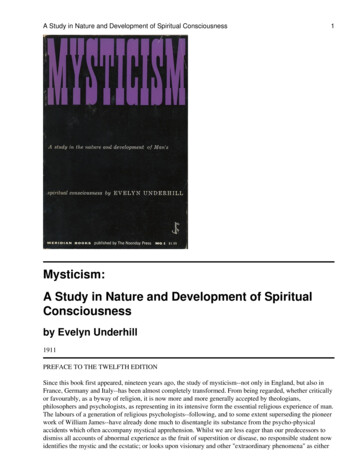
Transcription
A Study in Nature and Development of Spiritual Consciousness1Mysticism:A Study in Nature and Development of SpiritualConsciousnessby Evelyn Underhill1911PREFACE TO THE TWELFTH EDITIONSince this book first appeared, nineteen years ago, the study of mysticism--not only in England, but also inFrance, Germany and Italy--has been almost completely transformed. From being regarded, whether criticallyor favourably, as a byway of religion, it is now more and more generally accepted by theologians,philosophers and psychologists, as representing in its intensive form the essential religious experience of man.The labours of a generation of religious psychologists--following, and to some extent superseding the pioneerwork of William James--have already done much to disentangle its substance from the psycho-physicalaccidents which often accompany mystical apprehension. Whilst we are less eager than our predecessors todismiss all accounts of abnormal experience as the fruit of superstition or disease, no responsible student nowidentifies the mystic and the ecstatic; or looks upon visionary and other "extraordinary phenomena" as either
by Evelyn Underhill2guaranteeing or discrediting the witness of the mystical saints. Even the remorseless explorations anddestructive criticisms of the psycho-analytic school are now seen to have effected a useful work; throwing intorelief the genuine spiritual activities of the psyche, while explaining in a naturalistic sense some of their lessfortunate psycho-physical accompaniments. The philosophic and theological landscape also, with itsincreasing emphasis on Transcendence, its new friendliness to the concept of the Supernatural, is becomingever more favourable to the metaphysical claims of the mystics. On one hand the prompt welcome given tothe work of Rudolf Otto and Karl Barth, on the other the renewed interest in Thomist philosophy, seem toindicate a growing recognition of the distinctness and independence of the Spiritual Order. and a revival of thecreaturely sense, strongly contrasting with the temper of late nineteenth-century thought.Were I, then, now planning this book for the first time, its arguments would be differently stated. Moreemphasis would be given (a) to the concrete, richly living yet unchanging character of the Reality over againstthe mystic, as the first term, cause and incentive of his experience; (b) to that paradox of utter contrast yetprofound relation between the Creator and the creature, God and the soul, which makes possible hisdevelopment; (c) to the predominant part played in that development by the free and prevenient action of theSupernatural--in theological language, by "grace"--as against all merely evolutionary or emergent theories ofspiritual transcendence. I feel more and more that no psychological or evolutionary treatment of man'sspiritual history can be adequate which ignores the element of "given-ness" in all genuine mysticalknowledge. Though the mystic Life means organic growth, its first term must be sought in ontology; in theVision of the Principle, as St. Gregory the Great taught long ago. For the real sanction of that life does notinhere in the fugitive experiences or even the transformed personality of the subject; but in the metaphysicalObject which that subject apprehends.Again, it now seems to me that a critical realism, which found room for the duality of our full humanexperience--the Eternal and the Successive, supernatural and natural reality--would provide a betterphilosophic background to the experience of the mystics than the vitalism which appeared, twenty years ago,to offer so promising a way of escape from scientific determinism. Determinism--more and more abandonedby its old friends the physicists--is no longer the chief enemy to such a spiritual interpretation of life as isrequired by the experience of the mystics. It is rather a naturalistic monism, a shallow doctrine of immanenceunbalanced by any adequate sense of transcendence, which now threatens to re-model theology in a sensewhich leaves no room for the noblest and purest reaches of the spiritual life.Yet in spite of the adjustments required by such a shifting at the philosophic outlook, and by nearly twentyyears of further study and meditation, the final positions which seem to me to be required by the existence ofmysticism remain substantially unchanged. Twenty years ago, I was already convinced that the facts of man'sspiritual experience pointed to a limited dualism; a diagram which found place for his contrastingapprehension of Absolute and Contingent, Being and Becoming, Simultaneous and Successive. Further, thatthese facts involved the existence in him too of a certain doubleness, a higher and lower, natural andtranscendental self--something equivalent to that "Funklein" spark, or apex of the soul on which the mysticshave always insisted as the instrument of their special experience. Both these opinions were then unpopular.The second, in particular, has been severely criticized by Professor Pratt and other authorities on thepsychology of religion. Yet the constructive work which has since been done on the metaphysical implicationsof mystical experience has tended more and more to establish their necessity, at least as a basis of analysis;and they can now claim the most distinguished support.The recovery of the concept of the Supernatural--a word which no respectable theologian of the lastgeneration cared to use--is closely linked with the great name of Friedrich von Hügel. His persistentopposition to all merely monistic, pantheist and immanental philosophies of religion, and his insistence on theneed of a "two-step diagram" of the Reality accessible to man, though little heeded in his life-time, are nowbearing fruit. This re-instatement of the Transcendent, the "Wholly Other," as the religious fact, is perhaps themost fundamental of the philosophic changes which have directly affected the study of mysticism. It thusobtains a metaphysical background which harmonizes with its greatest declarations, and supports its claim to
by Evelyn Underhill3empirical knowledge of the Truth on which all religion rests. Closely connected with the transcendence of itsObject, are the twin doctrines emphasized in all Von Hügel's work. First, that while mysticism is an essentialelement in full human religion, it can never be the whole content of such religion. It requires to be embodiedin some degree in history, dogma and institutions if it is to reach the sense-conditioned human mind.Secondly, that the antithesis between the religions of "authority" and of "spirit," the "Church" and the"mystic," is false. Each requires the other. The "exclusive" mystic, who condemns all outward forms andrejects the support of the religious complex, is an abnormality. He inevitably tends towards pantheism, andseldom exhibits in its richness the Unitive Life. It is the "inclusive" mystic, whose freedom and originality arefed but not hampered by the spiritual tradition within which he appears, who accepts the incarnational statusof the human spirit, and can "find the inward in the outward as well as the inward in the inward," who showsus in their fullness and beauty the life-giving possibilities of the soul transfigured in God.Second in importance among the changes which have come over the study of mysticism, I should reckon thework done during the last decade upon the psychology of prayer and contemplation. I cannot comment hereupon the highly technical discussions between experts as to the place where the line is to be drawn between"natural" and "supernatural," "active" and "infused" operations of the soul in communion with God; or theexact distinction between "ordinary" and "extraordinary" contemplation. But the fact that these discussionshave taken place is itself significant; and requires from religious psychology the acknowledgement of agenuine two-foldness in human nature--the difference in kind between Animus the surface-self and Anima thetranscendental self, in touch with supernatural realities. Here, the most important work has been done inFrance; and especially by the Abbé Bremond, whose "Prière et Poésie" and "Introduction a la Philosophie dela Prière"--based on a vast acquaintance with mystical literature--mark, I believe, the beginning of a newunderstanding of the character of contemplation. The Thomist philosophy of Maritain, and the psychologicalresearches of Maréchal, tend to support this developing view of the mystical experience, even in itselementary forms, as an activity of the transcendental self; genuinely supernatural, yet not necessarilyinvolving any abnormal manifestations, and linked by the ascending "degrees of prayer" with the subject's"ordinary" religious life. This disentangling of the substance of mysticism from the psycho-physical accidentsof trance, ecstasy, vision and other abnormal phenomena which often accompany it, and its vindication assomething which gives the self a genuine knowledge of transcendental Reality--with its accompanyingdemonstration of the soberness and sanity of the greatest contemplative saints--is the last of the beneficentchanges which have transformed our study of the mystics. In this country it is identified with the work of twoBenedictine scholars; Abbot Chapman of Downside and Dom Cuthbert Butler, whose "Western Mysticism" isa masterly exhibition of the religious and psychological normality of the Christian contemplative life, asdeveloped by its noblest representatives.Since this book was written, our knowledge of the mystics has been much extended by the appearance ofcritical texts of many writings which had only been known to us in garbled versions; or in translations madewith an eye to edification rather than accuracy. Thus the publication of the authentic revelations of Angela ofFoligno--one of the most interesting discoveries of recent years--has disclosed the unsuspected splendour ofher mystical experience. The critical texts of St. Teresa and St. John of the Cross which are now availableamend previous versions in many important respects. We have reliable editions of Tauler and Ruysbroeck; of"The Cloud of Unknowing," and of Walter Hilton's works. The renewed interest in seventeenth-centurymysticism, due in part to the Abbé Bremond's great work, has resulted in the publication of many of itsdocuments. So too the literary, social and historical links between the mystics, the influence of environment,the great part played by forgotten spiritual movements and inarticulate saints, are beginning to be betterunderstood. Advantage has been taken of these facts in preparing the present edition. All quotations from themystics have been revised by comparison with the best available texts. The increased size of the historicalappendix and bibliography is some indication of the mass of fresh material which is now at the disposal ofstudents; material which must be examined with truth-loving patience, with sympathy, and above all withhumility, by those who desire to make valid additions to our knowledge of the conditions under which thehuman spirit has communion with God.
by Evelyn Underhill4Easter 1930 E. U.***PREFACE TO THE FIRST EDITIONThis book falls naturally into two parts; each of which is really complete in itself, though they are in a sensecomplementary to one another. Whilst the second and longest part contains a somewhat detailed study of thenature and development of man's spiritual or mystical consciousness, the first is intended rather to provide anintroduction to the general subject of mysticism. Exhibiting it by turns from the point of view of metaphysics,psychology, and symbolism, it is an attempt to gather between the covers of one volume information atpresent scattered amongst many monographs and text-books written in divers tongues, and to give the studentin a compact form at least the elementary facts in regard to each of those subjects which are most closelyconnected with the study of the mystics.Those mystics, properly speaking, can only be studied in their works: works which are for the most part leftunread by those who now talk much about mysticism. Certainly the general reader has this excuse, that themasterpieces of mystical literature, full of strange beauties though they be, offer considerable difficulties tothose who come to them unprepared. In the first seven chapters of this book I have tried to remove a few ofthese difficulties; to provide the necessary preparation; and to exhibit the relation in which mysticism standsto other forms of life. If, then, the readers of this section are enabled by it to come to the encounter of mysticalliterature with a greater power of sympathetic comprehension than they previously possessed, it will haveserved the purpose for which it has been composed.It is probable that almost every such reader, according to the angle from which he approaches the subject, willhere find a good deal which seems to him superfluous. But different types of mind will find this unnecessaryelaboration in different places. The psychologist, approaching from the scientific standpoint, eager for morbidphenomena, has little use for disquisitions on symbolism, religious or other. The symbolist, approaching fromthe artistic standpoint, seldom admires the proceedings of psychology. I believe, however, that none who wishto obtain an idea of mysticism in its wholeness, as a form of life, can afford to neglect any of the aspects onwhich these pages venture to touch. The metaphysician and the psychologist are unwise if they do notconsider the light thrown upon the ideas of the mystics by their attitude towards orthodox theology. Thetheologian is still more unwise if he refuse to hear the evidence of psychology. For the benefit of those whoseinterest in mysticism is chiefly literary, and who may care to be provided with a clue to the symbolic andallegorical element in the writings of the contemplatives, a short section on those symbols of which they mostoften make use has been added. Finally, the persistence amongst us of the false opinion which confusesmysticism with occult philosophy and psychic phenomena, has made it necessary to deal with the vitaldistinction which exists between it and every form of magic.Specialists in any of these great departments of knowledge will probably be disgusted by the elementary andsuperficial manner in which their specific sciences are here treated. But this book does not venture to addressitself to specialists. From those who are already fully conversant with the matters touched upon, it asks theindulgence which really kindhearted adults are always ready to extend towards the efforts of youth.Philosophers are earnestly advised to pass over the first two chapters, and theologians to practise the samecharity in respect of the section dealing with their science.The giving of merely historical information is no part of the present plan: except in so far as chronology has abearing upon the most fascinating of all histories, the history of the spirit of man. Many books uponmysticism have been based on the historical method: amongst them two such very different works asVaughan's supercilious and unworthy "Hours with the Mystics" and Dr. Inge's scholarly Bampton lectures. Itis a method which seems to be open to some objection: since mysticism avowedly deals with the individualnot as he stands in relation to the civilization of his time, but as he stands in relation to truths that are timeless.
by Evelyn Underhill5All mystics, said Saint-Martin, speak the same language and come from the same country. As against thatfact, the place which they happen to occupy in the kingdom of this world matters little. Nevertheless, thosewho are unfamiliar with the history of mysticism properly so called, and to whom the names of the greatcontemplatives convey no accurate suggestion of period or nationality, may be glad to have a short statementof their order in time and distribution in space. Also, some knowledge of the genealogy of mysticism isdesirable if we are to distinguish the original contributions of each individual from the mass of speculationand statement which he inherits from the past. Those entirely unacquainted with these matters may find ithelpful to glance at the Appendix before proceeding to the body of the work; since few things are moredisagreeable than the constant encounter of persons to whom we have not been introduced.The second part of the book, for which the first seven chapters are intended to provide a preparation, isavowedly psychological. It is an attempt to set out and justify a definite theory of the nature of man's mysticalconsciousness: the necessary stages of organic growth through which the typical mystic passes, the state ofequilibrium towards which he tends. Each of these stages--and also the characteristically mystical and stilllargely mysterious experiences of visions and voices, contemplation and ecstasy--though viewed from thestandpoint of psychology, is illustrated from the lives of the mystics; and where possible in their own words.In planning these chapters I have been considerably helped by M. Delacroix's brilliant "Etudes sur leMysticisme," though unable to accept his conclusions: and here gladly take the opportunity of acknowledgingmy debt to him and also to Baron von Hügel's classic "Mystical Element of Religion." This book, which onlycame into my hands when my own was planned and partly written, has since been a constant source ofstimulus and encouragement.Finally, it is perhaps well to say something as to the exact sense in which the term "mysticism" is hereunderstood. One of the most abused words in the English language, it has been used in different and oftenmutually exclusive senses by religion, poetry, and philosophy: has been claimed as an excuse for every kindof occultism, for dilute transcendentalism, vapid symbolism, religious or aesthetic sentimentality, and badmetaphysics. On the other hand, it has been freely employed as a term of contempt by those who havecriticized these things. It is much to be hoped that it may be restored sooner or later to its old meaning, as thescience or art of the spiritual life.Meanwhile, those who use the term "Mysticism" are bound in self-defence to explain what they mean by it.Broadly speaking, I understand it to be the expression of the innate tendency of the human spirit towardscomplete harmony with the transcendental order; whatever be the theological formula under which that orderis understood. This tendency, in great mystics, gradually captures the whole field of consciousness; itdominates their life and, in the experience called "mystic union," attains its end. Whether that end be calledthe God of Christianity, the World-soul of Pantheism, the Absolute of Philosophy, the desire to attain it andthe movement towards it--so long as this is a genuine life process and not an intellectual speculation--is theproper subject of mysticism. I believe this movement to represent the true line of development of the highestform of human consciousness.It is a pleasant duty to offer my heartiest thanks to the many kind friends and fellow students, of all shades ofopinion, who have given me their help and encouragement. Amongst those to whom my heaviest debt ofgratitude is due are Mr. W. Scott Palmer, for much valuable, generous, and painstaking assistance, particularlyin respect of the chapter upon Vitalism: and Miss Margaret Robinson, who in addition to many other kindoffices, has made all the translations from Meister Eckhart and Mechthild of Magdeburg here given.Sections of the MS. have been kindly read by the Rev. Dr. Inge, by Miss May Sinclair, and by Miss EleanorGregory; from all of whom I have received much helpful and expert advice. To Mr. Arthur Symons my thanksand those of my readers are specially due; since it is owing to his generous permission that I am able to makefull use of his beautiful translations of the poems of St. John of the Cross. Others who have given me muchhelp in various directions, and to whom most grateful acknowledgments are here offered, are Miss ConstanceJones, Miss Ethel Barker, Mr. J. A. Herbert of the British Museum--who first brought to my notice the newly
by Evelyn Underhill6discovered "Mirror of Simple Souls"--the Rev. Dr. Arbuthnot Nairn, Mr. A. E. Waite, and Mr. H. StuartMoore, F.S.A. The substance of two chapters--those upon "The Characteristics of Mysticism" and "Mysticismand Magic"--has already appeared in the pages of The Quest and The Fortnightly Review. These sections arehere reprinted by kind permission of their respective editors.Feast of St. John of the Cross E. U.1910***"What the world, which truly knows nothing, calls mysticism' is the science of ultimates, . . . the science ofself-evident Reality, which cannot be reasoned about,' because it is the object of pure reason or perception.The Babe sucking its mother's breast, and the Lover returning, after twenty years' separation, to his home andfood in the same bosom, are the types and princes of Mystics."COVENTRY PATMORE,"The Rod, the Root, and the Flower"***T he most highly developed branches of the human family have in common one peculiar characteristic. Theytend to produce--sporadically it is true, and often in the teeth of adverse external circumstances--a curious anddefinite type of personality; a type which refuses to be satisfied with that which other men call experience,and is inclined, in the words of its enemies, to "deny the world in order that it may find reality." We meetthese persons in the east and the west; in the ancient, mediaeval, and modern worlds. Their one passionappears to be the prosecution of a certain spiritual and intangible quest: the finding of a "way out" or a "wayback" to some desirable state in which alone they can satisfy their craving for absolute truth. This quest, forthem, has constituted the whole meaning of life. They have made for it without effort sacrifices which haveappeared enormous to other men: and it is an indirect testimony to its objective actuality, that whatever theplace or period in which they have arisen, their aims, doctrines and methods have been substantially the same.Their experience, therefore, forms a body of evidence, curiously self-consistent and often mutuallyexplanatory, which must be taken into account before we can add up the sum of the energies and potentialitiesof the human spirit, or reasonably speculate on its relations to the unknown world which lies outside theboundaries of sense.All men, at one time or another, have fallen in love with the veiled Isis whom they call Truth. With most, thishas been a passing passion: they have early seen its hopelessness and turned to more practical things. Butothers remain all their lives the devout lovers of reality: though the manner of their love, the vision which theymake to themselves of the beloved object varies enormously. Some see Truth as Dante saw Beatrice: anadorable yet intangible figure, found in this world yet revealing the next. To others she seems rather an evilbut an irresistible enchantress: enticing, demanding payment and betraying her lover at the last. Some haveseen her in a test tube, and some in a poet's dream: some before the altar, others in the slime. The extremepragmatists have even sought her in the kitchen; declaring that she may best be recognized by her utility. Laststage of all, the philosophic sceptic has comforted an unsuccessful courtship by assuring himself that hismistress is not really there.Under whatsoever symbols they have objectified their quest, none of these seekers have ever been able toassure the world that they have found, seen face to face, the Reality behind the veil. But if we may trust thereports of the mystics--and they are reports given with a strange accent of certainty and good faith--they havesucceeded where all these others have failed, in establishing immediate communication between the spirit of
by Evelyn Underhill7man, entangled as they declare amongst material things, and that "only Reality," that immaterial and finalBeing, which some philosophers call the Absolute, and most theologians call God. This, they say--and heremany who are not mystics agree with them--is the hidden Truth which is the object of man's craving; the onlysatisfying goal of his quest. Hence, they should claim from us the same attention that we give to otherexplorers of countries in which we are not competent to adventure ourselves; for the mystics are the pioneersof the spiritual world, and we have no right to deny validity to their discoveries, merely because we lack theopportunity or the courage necessary to those who would prosecute such explorations for themselves.It is the object of this book to attempt a description, and also--though this is needless for those who read thatdescription in good faith--a justification of these experiences and the conclusions which have been drawnfrom them. So remote, however, are these matters from our ordinary habits of thought, that their investigationentails, in those who would attempt to understand them, a definite preparation: a purging of the intellect. Aswith those who came of old to the Mysteries, purification is here the gate of knowledge. We must come to thisencounter with minds cleared of prejudice and convention, must deliberately break with our inveterate habit oftaking the "visible world" for granted; our lazy assumption that somehow science is "real" and metaphysics isnot. We must pull down our own card houses--descend, as the mystics say, "into our nothingness"--andexamine for ourselves the foundations of all possible human experience, before we are in a position tocriticize the buildings of the visionaries, the poets, and the saints. We must not begin to talk of the unrealworld of these dreamers until we have discovered--if we can--a real world with which it may be compared.Such a criticism of reality is of course the business of philosophy. I need hardly say that this book is notwritten by a philosopher, nor is it addressed to students of that imperial science. Nevertheless, amateursthough we be, we cannot reach our starting-point without trespassing to some extent on philosophic ground.That ground covers the whole area of first principles: and it is to first principles that we must go, if we wouldunderstand the true significance of the mystic type.Let us then begin at the beginning: and remind ourselves of a few of the trite and primary facts which allpractical persons agree to ignore. That beginning, for human thought, is of course the I, the Ego, theself-conscious subject which is writing this book, or the other self-conscious subject which is reading it; andwhich declares, in the teeth of all arguments, I AM. [1] Here is a point as to which we all feel quite sure. Nometaphysician has yet shaken the ordinary individual's belief in his own existence. The uncertainties onlybegin for most of us when we ask what else is .To this I, this conscious self "imprisoned in the body like an oyster in his shell," [2] come, as we know, aconstant stream of messages and experiences. Chief amongst these are the stimulation of the tactile nerveswhose result we call touch, the vibrations taken up by the optic nerve which we call light, and those taken upby the ear and perceived as sound.What do these experiences mean? The first answer of the unsophisticated Self is, that they indicate the natureof the external world: it is to the "evidence of her senses" that she turns, when she is asked what the world islike. From the messages received through those senses, which pour in on her whether she will or no, batteringupon her gateways at every instant and from every side, she constructs that "sense-world" which is the "realand solid world" of normal men. As the impressions come in--or rather those interpretations of the originalimpressions which her nervous system supplies--she pounces on them, much as players in the spelling gamepounce on the separate letters dealt out to them. She sorts, accepts, rejects, combines: and then triumphantlyproduces from them a "concept" which is, she says, the external world. With an enviable and amazingsimplicity she attributes her own sensations to the unknown universe. The stars, she says, are bright; the grassis green. For her, as for the philosopher Hume, "reality consists in impressions and ideas."It is immediately apparent, however, that this sense-world, this seemingly real external universe--though itmay be useful and valid in other respects--cannot be the external world, but only the Self's projected picture ofit. [3] It is a work of art, not a scientific fact; and, whilst it may well possess the profound significance proper
by Evelyn Underhill8to great works of art, is dangerous if treated as a subject of analysis. Very slight investigation shows that it is apicture whose relation to reality is at best symbolic and approximate, and which would have no meaning forselves whose senses, or channels of communication, happened to be arranged upon a different plan. Theevidence of the senses, then, cannot be accepted as evidence of the nature of ultimate reality: useful servants,they are dangerous guides. Nor can their testimony disconcert those seekers whose reports they appear tocontradict.The conscious self sits, so to speak, at the receiving end of a telegraph wire. On any other theory than that ofmysticism, it is her one channel of communication with the hypothetical "external world." The receivinginstrument registers certain messages. She does not know, and--so long as she remains dependent on thatinstrument--never can know, the object, the reality at the other end of the wire, by which those messages aresent; neither can the messages truly disclose the nature of that object. But she is justified on the whole inaccepting them as evidence that something exists beyond herself and her receiving instrument. It
nature and development of man's spiritual or mystical consciousness, the first is intended rather to provide an introduction to the general subject of mysticism. Exhibiting it by turns from the point of view of metaphysics, psychology, and symbolism, it is an attempt
